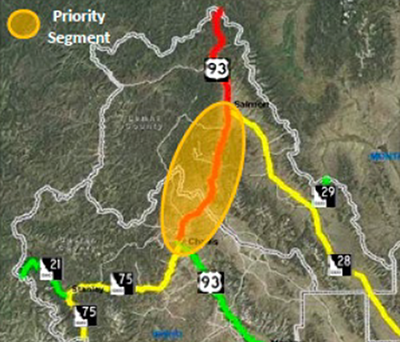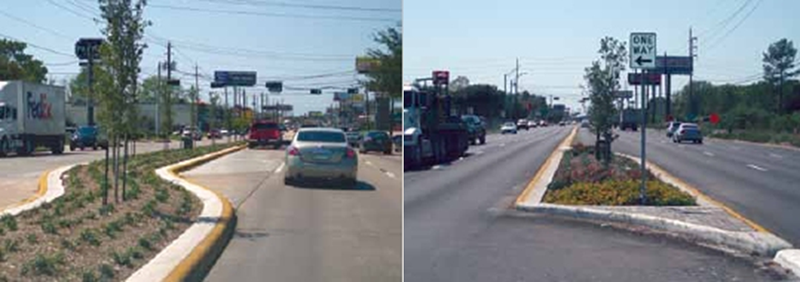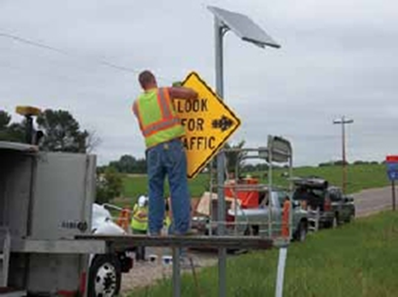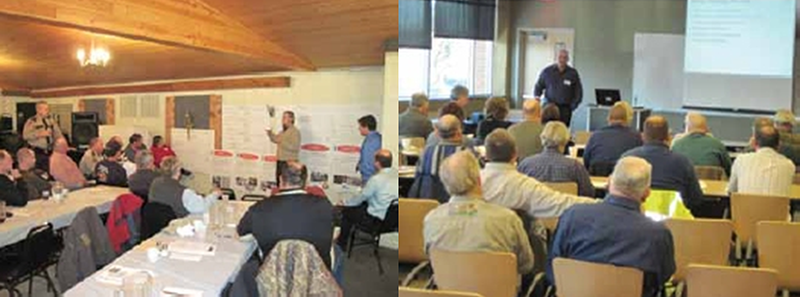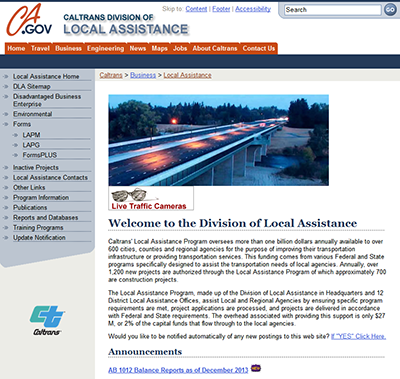North Dakota Integrates its SHSP with Other State Plans and Programs
The North Dakota practice is discussed after the following introduction about SHSP integration.
Other states in this SHSP Integration Noteworthy Practices series: DE, ID, ME, MD, WA
Introduction to SHSP Integration
The Strategic Highway Safety Plan (SHSP) is a statewide-coordinated safety plan that provides a comprehensive framework for reducing the number of deaths and serious injuries on all public roads. In each State, the SHSP identifies the State's safety goals, objectives and key emphasis areas. It is intended to serve as an ‘umbrella’ plan that is integrated into other State transportation plans and guides the State's roadway safety investment decisions.
Integration Defined
Integration is the act of bringing together or incorporating various parts into a whole. Integration is relevant and important to a State's planning process because every State has numerous transportation plans; each one potentially addressing safety in a different way. The SHSP is the mechanism to bring these safety “parts” together to form a consistent and “whole” safety program for the State.
The Purpose and Benefits of Integration
The purpose of integration is to coordinate and focus the State's roadway safety efforts to maximize the State's ability to save lives.
Through integration, the safety needs of the State can be addressed more strategically and resources can be shared more effectively. As illustrated in Figure 1, integration encourages State partners to strive toward common goals, collectively implement appropriate strategies and actions, share resources to meet or exceed the State's goals and objectives, and most importantly to save lives.

Other potential integration benefits include:
- The use of consistent data and analysis methods.
- Improved allocation of resources to more effectively produce safety improvements.
- Improvements to safety culture across State, regional, and local agencies.
- A reduction in the administrative burden on States and local agencies.
Integration of Plans and Processes
State transportation plans and programs that the SHSP should be integrated with include the Statewide Long Range Transportation Plan (LRTP), Statewide Transportation Improvement Plan (STIP), State Highway Safety Improvement Programs (HSIPs), the Commercial Vehicle Safety Plan (CVSP), the Highway Safety Plan (HSP) Metropolitan Transportation Plans (TIPs), and various modal and regional transportation plans. The relationship of these plans is illustrated in Figure 2.
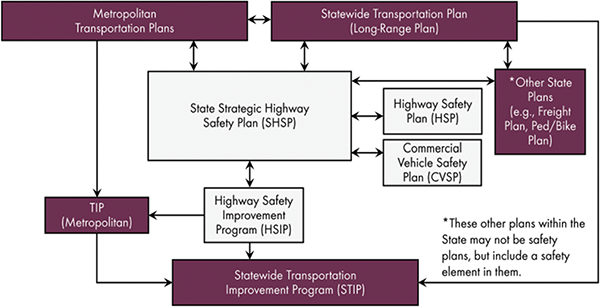
An integrated SHSP positions the State DOT and its safety partners to collectively address the State's safety challenges on all public roads through coordination and consistency among with the following State and regional plans and programs:
- LRTPs to promote a long-range vision that incorporates safety priorities.
- HSIP projects to be consistent with the SHSP emphasis areas and strategies.
- STIPS/TIPS to align programming of projects with SHSP strategies and countermeasures.
- CVSPs to facilitate exchange and collaboration between the commercial motor vehicle safety community and the broader safety community.
- HSPs to ensure a consistent, data-driven approach to improving highway safety, especially in SHSP emphasis areas.
In addition, the SHSP should integrate with city and county planning processes to ensure consideration of safety concerns on all road types.
SHSP Integration Indicators
Indicators that the SHSP and other transportation plans and processes are integrated include the following:
- Other transportation plans incorporate elements of the SHSP and include consistent and supporting safety goals, performance measures, objectives, and strategies.
- The priorities and goals of other transportation programs and plans are considered when developing the SHSP.
- Safety partners have access to and use of common safety data, analysis, and methods for determining safety priorities.
- The SHSP is developed with sustained input from disciplines and agencies representing the 4Es of safety (engineering, enforcement, education, and emergency medical services).
- Safety partners assist in the implementation of SHSP strategies.
- SHSP stakeholders and experts are included in other transportation planning processes.
- SHSP priorities and strategies are considered in project prioritization and programming.
- Various sources of funding are used to achieve safety goals.
- Progress towards safety goals is measured jointly and regularly.
North Dakota
Background
The North Dakota Department of Transportation (NDDOT) Safety Division is responsible for coordinating the development and implementation of the State's Strategic Highway Safety Plan (SHSP). North Dakota recently updated the SHSP using a collaborative process that included a wide range of safety stakeholders including Federal, State, local, and private sector entities. The SHSP provides an overview of traffic safety issues and trends, goals, emphasis areas, initiatives, programs, and achievements to promote traffic safety in North Dakota.
SHSP Integration Practices
Collaborative Development
Through the SHSP, the North Dakota DOT promotes coordination with other traffic safety partners and initiatives throughout the state. The SHSP process has led to closer coordination among safety agencies. With each update, NDDOT has increased the number of stakeholders involved in the process.
The 2013 North Dakota SHSP update was led by the leadership of the NDDOT, in consultation with safety partners across the state who worked collaboratively towards their overall goal of eliminating all traffic fatalities and serious injuries on all North Dakota roads. At the onset, the SHSP was developed under the guidance of a steering committee consisting of representatives from NDDOT, the North Dakota Department of Health Division of Emergency Medical Services and Trauma, the North Dakota Highway Patrol, Federal Highway Administration (FHWA), and National Highway Traffic Safety Administration (NHTSA). To further incorporate stakeholder input into the SHSP, NDDOT invited about 100 4E stakeholders representing education, enforcement, engineering, and EMS from across the State to a workshop where they reviewed State safety data and identified strategies for implementation.
In addition to reviewing data, the SHSP steering committee also referred to associated safety plans and programs including the Traffic Records Strategic Plan and the Highway Safety Plan (HSP). The SHSP Steering Committee took part in the HSP data analysis and planning functions as well.
The NDDOT Safety Division is responsible for developing both the SHSP and the HSP. As a result, the SHSP and HSP are closely aligned. Strategies in the HSP are consistent with the SHSP priority emphasis areas and evidence-based strategies. In fact, the completed SHSP was used as a basis for selecting strategies for inclusion in the current HSP. The link between the SHSP and HSP strategies and projects can be seen in the following example from the Alcohol-Related Emphasis Area.
The NDDOT Programming Division is responsible for developing and implementing the Highway Safety Improvement Program (HSIP). The Programming Division served on the SHSP steering committee and actively participated in the 2013 North Dakota SHSP update. The NDDOT HSIP uses a data-driven, strategic approach to improving highway safety on all public roads. The NDDOT ensures the HSIP projects are consistent with the data-driven SHSP. This is easily accomplished due to the close coordination between the Programming Division, Safety Division and local partners.
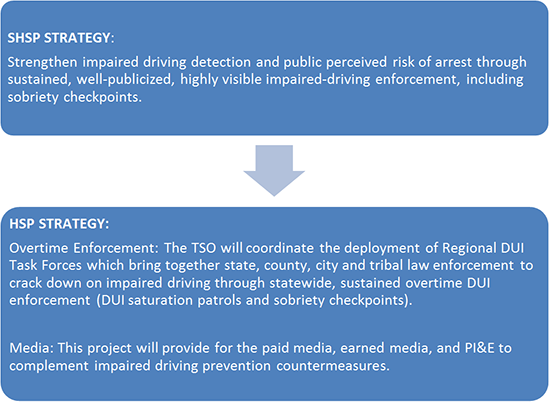
Consensus Safety Goal
North Dakota has established a long-term goal to eliminate all traffic fatalities on North Dakota's public roads. While it is widely recognized within the state that there is only one suitable long-term goal, it is also acknowledged that intermediate (short-term) goals are needed as benchmarks to measure progress. Intermediate goals also promote cooperation among agencies to accomplish these goals. Discussions were held with safety stakeholders to begin the process of selecting an intermediate goal. Due to the upward trend of traffic fatalities, there was unanimous support for an aggressive intermediate goal to reduce traffic fatalities, and several options were discussed. After considering the stakeholders' input, the SHSP Steering Committee selected reducing the 3-year average of traffic fatalities to 100 or fewer by 2020 (approximately a 3 percent reduction per year).
SHSP Implementation
North Dakota acknowledges that the development of a data-driven SHSP and adopting crash reduction goals is only the first step. Plans do not save lives, implementation does. To reverse the current trend and achieve the crash reduction goal, North Dakota commits to a comprehensive statewide highway safety program with implementation of high priority safety strategies along roadway systems and facilities defined to be at-risk. The basic components of this comprehensive program are working with the safety partners to implement the driver-behavior program, implement infrastructure improvements, improve emergency response, and improve reporting of crashes.
Local and Tribal Integration
The NDDOT made specific efforts to reach out to the Tribes within North Dakota to include them as SHSP stakeholders. Tribal traffic safety coordinators and law enforcement officials were included as part of the SHSP development process. This partnership with tribal stakeholders also included efforts to collect and share safety data and data analysis.
To ensure the implementation of the SHSP at the local level, NDDOT has led the development of local road safety plans. They intend to develop local road safety plans for all 53 counties, 12 major cities, and 4 tribes in North Dakota. As part of the process, they will collect and analyze safety data, hold formal regional workshops to select countermeasures, and document high risk local road locations and safety projects for implementation. The local road safety plans will help NDDOT carry out SHSP strategies at a local level by identifying data-driven safety projects on local roads for HSIP and HSP funding.
Key Accomplishments
- Incorporated stakeholder input into the SHSP from about 100 stakeholders
- Closely aligned SHSP, Highway Safety Improvement Program (HSIP) and Highway Safety Plan (HSP)
- Developing local road safety plans for each county and major city in North Dakota
See these other SHSP Integration Noteworthy Practices:
Contact
Mark Nelson
North Dakota Department of Transportation
(701) 328-4559
MNelson@nd.gov


